The Benefits of Python for Software Projects

Contents
Unrivaled expressiveness, code readability, and a huge community — these are just the most obvious advantages of Python that software developers cited as reasons they like it. The software engineering team at Waverley Software are big fans of Python. Our portfolio includes plenty of Python development projects. The technologies that use this programming language vary greatly and include web app development, IoT, DevOps, blockchain, and data science. The application domains have practically no limits, and Python may fit any industry with both simple and complex solutions.
What does all this mean for business owners and their software projects? Let’s drill down and see why Python language is such a popular coding language. Let’s dig into the advantages and disadvantages of using Python.
Pros and Cons of Python
Before we dive into the subject, it’s crucial to understand that one-size-fits-all solutions are simply not possible when choosing the primary programming language for a software product. There’s also no “best” programming language; or “easy to learn” language; each has advantages and disadvantages. Your choice will depend on your project’s technical requirements, desired timeframes, allocated budget, and other factors. Unless you are a tech-savvy person, the best way to find out your ideal implementation is to get expert advice. Our experienced software engineers can evaluate your project from different angles and suggest the most effective language to allow it to evolve.
Advantages of Python
As for the Python advantages, it has been one of the most beloved programming languages in the development community since 2003 and it still ranks third among the most popular programming languages in TIOBE index just behind Java and C. Unlike C, Python is considered easy to read, and easy to learn. It was also named Programming Language of the Year in 2007, 2010 and, more recently, in 2018. Furthermore, because Python is cross-platform, it can run on different operating systems such as Windows, macOS, and Linux. According to Stack Overflow’s 2020 survey, 45.8% of Python engineers develop their software using Windows while 27.5% work on macOS, and 26.6% prefer Linux.
Let’s take a look at why the Python language receives such high praise from developers.
Code Readability
Who doesn’t like clarity when reading a piece of text? A well-structured paragraph, written in straight-forward language is far easier to follow and understand than one that is overly long and weighed down with excess words and detail. The same applies to computer programming. When working on a software product, developers typically read and modify existing source code. Code readability directly affects the way it can be imported, used, and maintained. One of the most often-cited advantages of Python, code readability is crucial on huge projects with numerous team members because every developer on the product must be able to understand what their colleagues have contributed to or modified in the code. For newcomers to the project, code readability is especially important to help them quickly get up to speed.
The Minimalist Principle
In Python, similar to artistic writing, brevity is the soul of wit. The philosophy that stands behind this programming language advocates concise but expressive coding. As a result, it requires much less time, effort, and lines of code than in other programming languages to execute the same operations. What’s more, the less complicated the code, the less chance of bugs, and the cleaner the code will be. This is yet another of the Python advantages that appeal to both developers and company leaders.
Object-oriented Paradigm
Python supports several programming paradigms: object-oriented programming, procedural programming, and functional programming. The object-oriented paradigm of Python is great for solving complex software development challenges. As one more benefit of Python, It allows developers to follow the Don’t Repeat Yourself (DRY) concept and SOLID principles in programming. The object-oriented programming approach also encourages modality of code that makes life easier for programmers with simpler troubleshooting, streamlined problem solving, and the possibility to reuse code. These are just a few of the additional benefits of choosing Python development services.
Huge Standard Library
One more of Python’s advantages is the way it’s designed to be a highly extensible programming language with lots of additional packages to offer. In keeping with the minimalist principle, Python avoids overloading programmers with features they don’t need. This allows them to make good use of the modular nature of this language and have a variety of tools at the ready to perform necessary tasks. Also as a part of the standard library
Python has more than 200,000 third-party packages to offer, the most popular ones being Django (Django Rest Framework), aiohttp, Flask, FastAPI, NumPy, SciPy, Keras, TensorFlow.
Community and Sustainability
Python language boasts a large supporting community of developers and contributors, with a dynamic fan-club that is continually growing. As a result, one can expect frequent updates, quick issue-fixes, and plenty of recommendations and answers to questions that arise. For product owners this makes it much easier to find good Python developers. Digging into the disadvantages and advantages of Python unit testing must be mentioned. Python has a built-in unit testing framework.
Development Efficiency
The benefits of learning Python such as great readability, word economy, abundance of white space and indentation also mean it is easy to use, takes less time to learn and less energy to understand the source code. And the clear, natural language-like syntax means fewer bugs to fix. Also, an extensive standard library plus the myriad of Python frameworks and libraries that are available for different purposes, combined with a mature supporting community means programmers can work quickly and efficiently.
Disadvantages of Python
The disadvantages of Python are few, but, like any programming language, Python has unfavorable aspects. Even Python fans agree that some of the criticism is appropriate and objective, whereas much of it may be due to lack of programming experience, insufficient background, or a simple matter of allegiance to another programming language. For example, Python’s limited use for mobile computing, or the fact that Python’s memory is not efficient, plus the processing power is rather slow. In the interest of an objective evaluation, there are a couple of Python disadvantages that are worth considering in order to make a fully-informed decision. Since the benefits of learning Python outweigh the disadvantages.
It’s Slow
Compared to some programming languages, Python’s execution speed is low the reason being: Python is an interpreted language. This means its source code gets executed without first compiling a program into machine-language instructions. The speed of such an execution is much lower than with compiled languages. However, this does add some flexibility and features not available with compiled implementations. It’s also high-level: it has a high degree of abstraction. In other words, it reads more like a natural language and hides all the computer details from the developer’s eyes. This does affect the execution speed but, at the same time, is what makes Python code so clean and readable.
Dynamic Type Checking
Python is dynamically typed meaning type checking is performed at runtime, and this increases memory consumption and slows down the operation making it one of the cons of Python. Also, with dynamically typed programming languages, such as Python, errors show up only during runtime, which makes a program less reliable. On the other hand, dynamically typed languages are more flexible and agile in processing, and developers find them easier to use. The solution is test-driven development (TDD), which solves the issue of errors and is one of the best development practices in any case. You kill two birds with one stone.
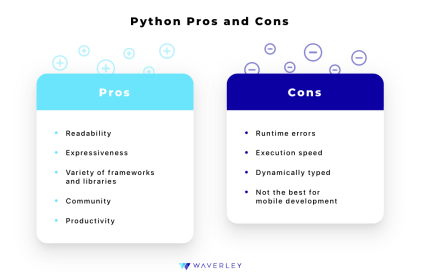
Taking into account the pros and cons of Python, the reason behind Python disadvantages offer benefits that outweigh the reduction in program execution speed. What’s more, it’s highly unlikely end users will notice at all. Given the overall increased productivity of dynamically typed languages, it’s no surprise that they, along with Python language, have found their niche in scientific computing, statistical analysis, scripting and automation.
What Can You Develop with Python?
As mentioned before, it’s hard to make a claim and state definitively that Python is the best language for a project without knowing that project’s details. However, taking into account all the pros and cons of using Python language there are areas where software developers prefer to use Python for good reason. One such reason, as mentioned earlier, is the wide range of standard and third-party libraries available. Let’s consider some of the application areas that are particularly well-positioned for Python development. See if any of these matches your project!
AI-powered Software
Projects relying on the Artificial Intelligence services and Machine Learning technologies are steadily gaining popularity. The benefits of Python programming language make it the #1 choice for projects involving AI and ML. The rich choice of Python frameworks and libraries designed specifically for machine learning makes it the leader in the field. TensorFlow, Keras, Pytorch, NumPy, SciPy, Scikit-learn, Pandas, and a number of other Python libraries for artificial intelligence offer a robust toolset to perform a variety of functions. This simple, highly-readable language frees Python programmers to concentrate on developing the sophisticated AI and ML algorithms rather than struggle with bulky code.
Data Science Projects
Python’s popularity among scientists and engineers to perform data analysis can not be underestimated. No other programming language is so dedicated to Data Science, Artificial Intelligence and Machine Learning development as Python with libraries such as Pandas, NumPy, SciPy, StatsModels, and Scikit-learn. Python programming language also makes it easy to create charts and graphs making use of data with great data visualization packages such as Matplotlib, Seaborn, Pandas plotting, and ggplot. Computer Vision is another major field at the crossroads of data science and machine learning extensively using Python frameworks.
One more feature data scientists love about Python is the ease of working with large datasets, the crucial task in Data Science. Also, being a general-purpose programming language, Python makes it easy to create CSV output for spreadsheets. Based on the figures and the Co-Occurrence Network Visualization of Data Science Skills provided by Glassdoor research, Python is the #1 must-have skill for Data Science engineers and is listed in 72 percent of job descriptions in the field.
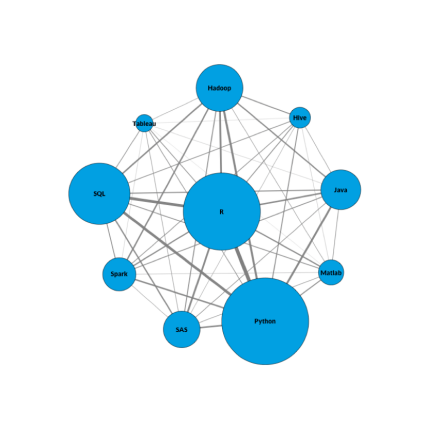
Natural Language Processing Applications
Natural Language Processing (NLP) tools are used to develop applications that need to understand and process human language, for example, voice recognition services. When it comes to natural language, millions of gigabytes of written and spoken texts are generated every day. That’s why NLP tools typically require Machine Learning algorithms and processing of large volumes of data to train the ML models. Due to Python’s modular nature, simple syntax, and robust text processing tools, Python development is highly efficient for projects involving NLP. The most popular library for natural language processing is Natural language toolkit (NLTK). No wonder NLTK is written in Python.
Blockchain Projects
An extensive list of specialized libraries is only one of the advantages of Python programming language that make it an excellent choice for building blockchain. Another benefit is, once again, the huge supporting community of Python software developers, an essential part of a stable blockchain ecosystem. This programming language has a flat learning curve, meaning even developers with less experience can join a blockchain project relatively quickly and start contributing right away. Python code can handle the kind of continually growing query list typical of blockchain. Also, due to code expressiveness, it’s possible to create a simple blockchain with as few as 50 lines of code using Python. Finally, being a scripted language, it doesn’t need compilation and offers pre-compiling that developers find convenient when working in blockchain.
Web App Development
According to a survey conducted by JetBrains, Python is most widely used for enterprise web app development. This is due to Python features and advantages such as readability and efficiency. For business owners, this means much faster development cycles and, in some cases, shorter time to market. Also, Python web development resource library is one of the best across all programming languages. Its highly-advanced third-party frameworks for web development (Django, Flask, FastAPI, aiohttp, Pylons, Pyramid, TurboGears, web2py, Tornado, Bottle and Zope) have robust functionality that allows developers to build complex solutions. Pyjs and IronPython are the frameworks that can be used to develop the front end of Ajax-based applications. This programming language is well-suited for scalable and fast RESTful APIs, with Flask, FastAPI, aiohttp being the best Python web development frameworks for this purpose.
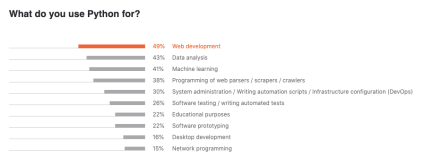
Cross-platform Software
Cross-platform software can be implemented on multiple computer platforms, across browsers, operating systems, and hardware. Among the many advantages of using Python is that it makes building cross-platform software easy and quick because it is an interpreted language. As a result, Python-powered software can run directly on any platform without building or compilation on each platform individually. This is also good for adapting enterprise legacy systems because gradual shifts can take place rather than completely rewriting code, which is more likely to happen with other programming languages.
Information Security Solutions
In cyber security, the rich library of Python frameworks lets you cater for a range of important tasks in the field, including malware analysis, scanning, and penetration testing. This programming language is great for data analysis, scripting and automating tasks that are so important for information security solutions. What’s more, modern cyber security software is leaning toward implementation of Artificial Intelligence and Machine Learning algorithms. As you already know, Python is the champion among other programming languages in AI, ML, and Data Science domains. AI-powered smart systems spot suspicious behavior patterns, predict malicious attacks and, in addition to performing plain data collection and analysis, immediately notify users of any security breach. Python’s simplistic nature comes in handy once again when cyber security professionals need to solve information security problems quickly and efficiently.
DevOps
DevOps is about agility, scalability, and automation. Python’s easy-to-remember and direct syntax makes it perfectly suited to the tasks of scripting and deployment automation. In fact, it has been recognized as the primary language used by DevOps specialists for its simplicity, readability, and flexibility. The aim of DevOps services is to streamline software product delivery and increase the development efficiency; as we already know, Python combines simplicity and code expressiveness in a highly productive programming language. It is considered a crucial part of the DevOps toolchain where speed truly matters. The benefits of using Python programming language in DevOps include a flat learning curve, accessibility, stability, multi-platform support, and broad community — all of which make DevOps and Python a perfect match.
Prototyping and Small Projects
Figures from Python Developers Survey by JetBrains show that the majority of Python programmers are engaged for small, self-contained projects employing 2-7 programmers. That’s no wonder, as Python is the fastest programming language in terms of productivity and tangible results with simple utilities that don’t need to be robust. Due to Python features such as accessibility and expressiveness, engineers can carry out software prototyping and MVP development quickly with Python. This gives startups a leg up over their competitors, enabling them to deliver their product to market sooner and win the funding they need. If your aim is to outrun your opponents and development speed is a do-or-die concern, you definitely want Python as your go-to language.

Open Source
Python is open source, all its modern versions are certified by the Open Source initiative. Python is developed under an OSI-approved license, making it distributable even for commercial use, so it is an open-source project.
Find Python Developers
With so many potential applications, including the wide usage of Python for web development, blockchain development, and DevOps, the job market for Python software developers is booming. Based on Stack Overflow statistics, Python is now the most widely discussed programming language in the development community, a strong indication that the supply of Python talent is high, and proof of the benefits of learning Python.
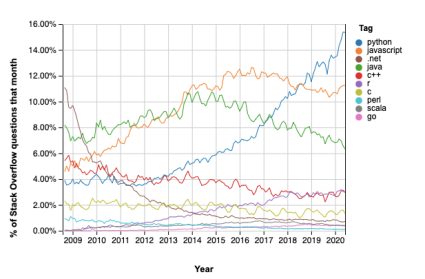
Because Python is clear and easy to read, as well as easy to learn, it is the programming language preferred by newbies in software development. As a result, more and more people are choosing to learn it and write software in Python.
On the other hand, Python development for complex and sophisticated solutions such as finding a vaccine for COVID-19 requires expertise and deep experience. Universities and research institutes take Python for statistical analysis purposes as the number one programming language for Data Science and Machine Learning. At the time of this writing, a huge amount of statistics and data mining is being conducted to address the COVID-19 crisis. Considering all the advantages of Python, it’s no surprise that software development experts in Python are in high demand.
Below are some figures that will help you understand the position of Python among other areas of expertise and the demographics within the Python community. We provide this information based on the most recent developer surveys conducted by Stack Overflow, JetBrains, and CodinGame.
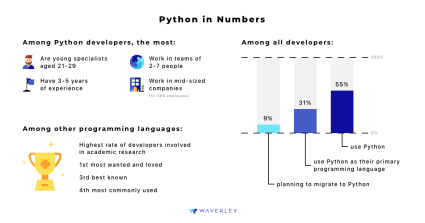
Waverley Software has access to a rich talent pool of experienced Python developers across the globe. Our in-house team counts as many as 230+ software engineering specialists and over 60% of them are Senior engineers. We successfully employ the best remote work practices and have development centers in South America, Eastern Europe, and South-East Asia. Deep expertise, experience, and a proven professional approach that makes collaboration both easy and effective are the qualities most valued at Waverley, ensuring customer satisfaction and resulting in our 4.9 rating on Clutch.
If you have any questions related to Python app development or other services, we’re here to serve you. Fill out the contact form and one of our representatives will reach out to you right away.



